
Love That Joker: Comics Alliance Reviews ‘Batman’ (1989), Part Two
On the occasion of the film’s 25th anniversary, ComicsAlliance represents our in-depth commentary and review of Tim Burton’s Batman ’89, the father of modern superhero cinema. Originally published in 2011 as part of our exhaustive Cinematic Batmanology series (which also included a massive five-part analysis of Christopher Nolan’s The Dark Knight), this piece by Chris Sims and David Uzumeri strips the fan favorite Batman ’89 down to the bone to get at what works, what doesn’t work, and what’s just plain crazy about Burton’s enduringly influential film.
If you missed part one of this review, click here to catch up.

Chris Sims: Welcome back to Remedial Batmanology, and the second half of our review of 1989's Batman, directed by Tim Burton and starring Michael Keaton and Jack Nicholson. Last week, we discussed the overwhelming cultural impact of the film and discussed the first 45 minutes of the movie itself. Any highlights you want to remind everyone of before we get into the rest of it, Uzi?
David Uzumeri: The story thus far: "legitimate businessman" Boss Grissom has been murdered by his number one guy, Jack Napier, who, after being set up over a frail (I've been reading way too much '80s Claremont), gets into a pugilistic altercation with the Bat-Man and falls into a vat of chemicals at Axis, emerging with white skin and green hair. The Bat-Man is wealthy, brooding gothic millionaire Bruce Wayne, who's just banged Pulitzer-winning photojournalist Vicki Vale, who's trying to find out both A) why Bruce Wayne is so weird and B) who the Batman is. She shares the second mission with Alexander Knox, an oft-mocked journalist at the Gotham Globe.
Chris: "Number one guy" aside, I don't think either one of us has really been keen on what we've seen, but it's in the second half that things start to go right off the rails.

David: Which brings us up to now, where Vale asks Knox to look up what the hell is going on with Bruce Wayne, and it turns out everything about him's been deleted from police records. Which seems pretty hard to pull off in 1989, when police records were actually sheets of paper you could not telnet into and delete.
Chris: I have to assume this is all Alfred's doing, since at one point Bruce asks him for Jack Napier's file, and Alfred chucks a massive stack of criminal records, psychological profiles and report cards at him so that we can have some tenuous reason for the second half of this flick to exist.
David: So Vicki does something that's pretty new to her in this movie: reporting. Or the investigative process leading thereto, except she never reports any of it. Basically, she stalks Bruce Wayne as he goes to Crime Alley to lay some flowers for his parents, assumedly because it's the anniversary of their death.
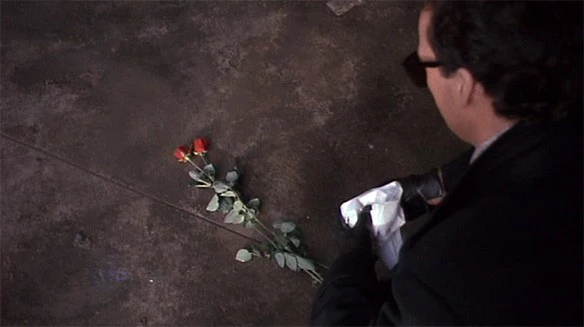
David: After this, we switch to what is, I swear to god, a press conference held by mobsters on the steps of Gotham City Hall, with some douchebag announcing that he's taking over Grissom's businesses.
Chris: I think they were signing the papers that gave them control of Grissom's business. Or gave the Joker control of their businesses. I really have no idea, although I like the fact that the movie's actual hero, Alex Knox, just straight up calls them out for being crooks.
David: Knox rules here here, seriously. He just has absolutely no fear. He's just mocking the hell out of these incredibly dangerous mobsters, because he is the only character in this movie with any balls or integrity. Then, the Joker kills the douchebag taking over the business with a well-aimed fountain pen to the throat, leading him to proclaim that "the pen is truly mightier than the sword." Then, Sam Hamm high-fived the mirror and drank a fifth of vodka. And Bruce Wayne. Just. Stands. And. Watches.
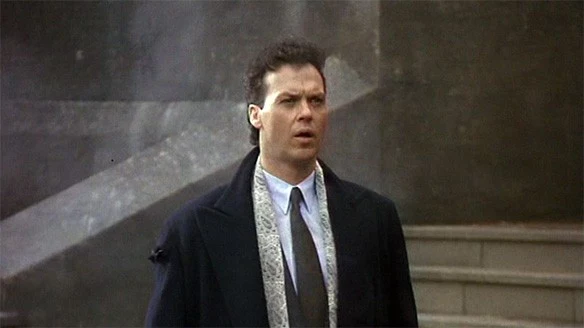
David: He doesn't even duck or play dead. He walks around with a stupefied look on his face, before being confronted by Vicki Vale for two seconds and then running off because he's afraid of cooties. This scene is TERRIBLE.
Chris: I could seriously talk for an hour about this scene. First of all: The movie everyone said returned Batman to his darker, more serious roots? Yeah, it has a scene with MOBSTER MIMES.
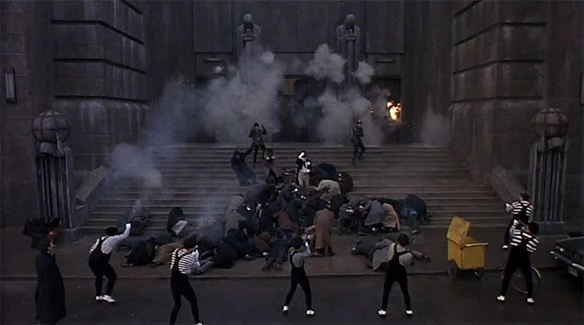
Chris: Second, the Joker just stone cold kills a guy on the steps of City Hall, and nobody does anything at all to stop him, especially -- as you've said -- Batman. Even the cops in Batman '66 weren't THAT incompetent.
David: Well, they're apparently also incontinent, because in the next scene the Joker uses a boxing glove gun to punch a television set and proclaim, famously, that "this town needs an enema."
Chris: Third, I have no idea why this is happening. I guess he says in the scene where he fries the guy with a joy buzzer that he's going to kill them all, but it's never explained why he would do this or what he gets out of it. I mean, I get that he's the Joker, and if any character should allowed to just kill people for no reason, it's him, but then, why the previous scene? What part of the plot did that advance?
David: If they were doing what the Joker wanted them to do, they'd be saying Jack Napier's running things, right? The movie never makes this clear, though.
Chris: Watching it again, I guess they're blocking Napier's takeover of Grissom's holdings? The apparently 100% legal takeover that wanted felon and presumed Batman Murder Victim Jack Napier is enacting? That has to be stopped by filing papers with the city tax office? Seriously, edge of your seat excitement here. Maybe the Joker showed up to kill them because he realized how dumb and boring this part of the movie was for pretty much everyone except Tim Burton.
David: Anyway, after Joker punches the TV, we get a scene where Alfred tries to make Bruce sweeter on Vicki, forcing Bruce to admit, begrudgingly, that she is "pretty great." Also, Vicki gets poor damn Alexander Knox to do research for her on what was up with those roses in that alleyway while she was stalking Bruce, which is pretty cruel of her to do.
Chris: Also, if I can nerd out for a second, I do think it's pretty ridiculous that the street address she gives Knox for the location of the Wayne murder wasn't on Park Row. Sure, it's a minor detail, but c'mon, that's like having Clark Kent raised in Littleton, Nebraska.
David: To be fair, Park Row could BE the alley at Pearl and Phillips. That's how I'm interpreting it, anyway. I also love how absolutely nobody remembers the Wayne murder, either. In the comics, it's usually a big deal that shakes up the city for a long time to come. Like, in the DCU, people probably tend to associate "Bruce Wayne" with "that dude whose parents were killed." Or did until very recently. I mean, I'm no big city history professor, but a lot of people remember Patty Hearst.
Chris: Yeah, it's this weird thing this movie has where nobody knows anything about Bruce Wayne, but he also has charity casino nights at where everyone in the city government shows up to roll dice. So is he the well-known philanthropist or the mysterious recluse? You can't have it both ways, movie. Why would Vicki Vale even bother with getting his official file, when Gordon, Dent and the Mayor seem to know this guy pretty well? Just ask around.
David: Well, it makes for a convenient narrative device allowing her to not find out for another 30 minutes of movie time.

David: Meanwhile, Joker's cutting up pictures of people affected by nerve agents for unexplained reasons (I guess some kind of collage -- this movie really tries to sell us on Napier being a brilliant artist), when Bob shows him some photos including one of Vicki Vale, who Napier immediately falls in love with. That's right, guys: this is a Batman movie where Batman and the Joker are fighting over the affection of a woman. Which would ALMOST work if Vicki actually found the Joker remotely interesting, but she just runs and screams a lot. It's a very acute isosceles love triangle.
Chris: It is seriously the driving conflict of this movie. The stuff about the Joker killing Batman's parents -- Spoiler Warning! -- barely figures into it. Which is good, because it's also dumb as hell. But we'll get to that.
David: Also, I'd like to mention that he's already gotten patches printed with what looks like a Dick Giordano Joker on them for all of his goons. Note: This Joker looks absolutely nothing like Jack Nicholson as the Joker.
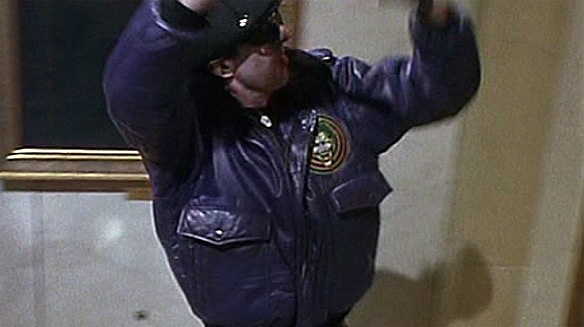
Chris: I actually love that, because that's exactly the kind of thing the Joker would do. Maybe he gets a deal on them when he shops at the store that sells canes that look just like his head. It makes me wonder, though. With all the Batman merchandise that was floating around in 1989, did they ever release Joker Goon jackets to the public? It seems like that would be a total no brainer. Can I buy one at the last remaning Warner Brothers store, which appears every hundred years like a retail Brigadoon?
David: But yeah, now we get to the Joker's villainous plan: shipping tons of products from Axis Chemicals with nerve agents in them to cause a citywide shopping nightmare. Two models are the first victims reported, leading to a scene where a female newsanchor with sweet, sweet, sweet '80s shoulderpads cracks up on the air because she apparently used the same deadly cosmetic products.
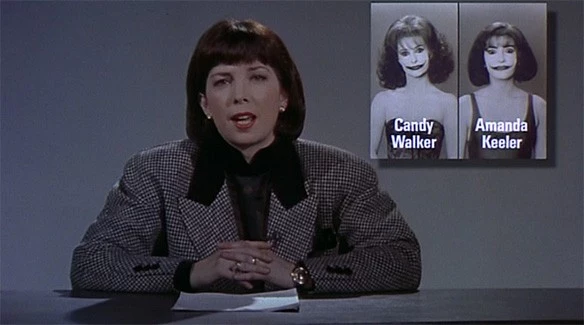
Chris: That's right, everyone: For those of you keeping score at home, the actual plot of the movie has finally showed up at 54 minutes in.
David: Joker takes over the feed to deliver this actually pretty funny mocking commercial, where he basically announces to everyone that anything you buy could kill you, after making you crack up. Bruce watches this commercial with that same stupefied look on his face.
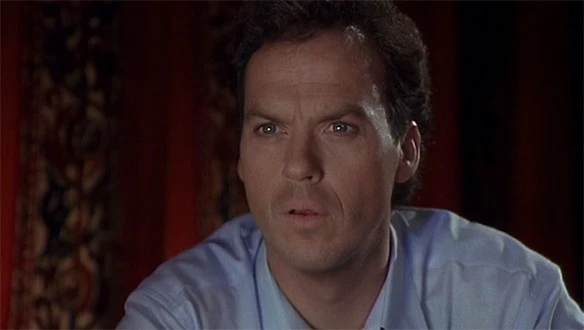
David: Alfred delivers him "information he requested" about Jack Napier, including that he's a brilliant psychopath with aptitudes in art, science and chemistry. That's right: science and chemistry.
Chris: And don't forget art! I wasn't kidding when I said that the Joker's permanent record provided the reason for every single thing that happens in the second half of this movie. Hamm's script just straight up announces "this is what the Joker's into," almost directly to the audience.
David: Yeah. Joker suddenly reinvents himself as a "homicidal artist," which is kind of a neat idea, but totally at odds with the entire first half of the damn flick.
Chris: Didn't Arkham Asylum come out in '89?
David: 1989, yeah. October. (I used Wikipedia, lazybones.)
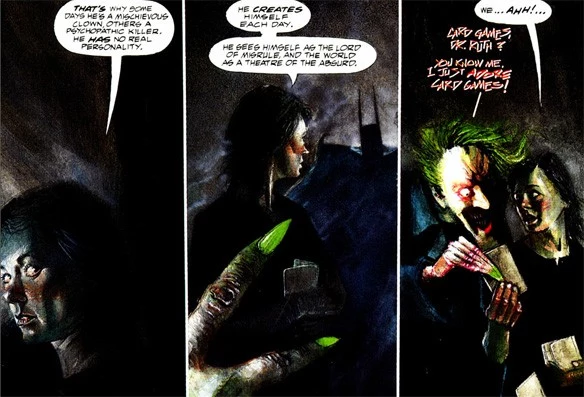
Chris: I almost wonder if Morrison's verison of the Joker as someone who constantly reinvents himself was informed by this movie, and the fact that millions and millions of people were seeing a guy who was a mob enforcer, then a guy trying to take over the mobs, then a guy with a team of evil mimes, then a guy who was going to kill everyone at random, then a guy who just wanted to be more popular than Batman, then a guy that wanted to kill everyone. It's like there are eight different Jokers in this movie, and I'll admit that his unpredictability would be kind of cool if I thought that he was written that way, you know, on purpose.
David: The next scene is actually pretty great, with the newsanchors reporting on the continuing scare, except that they both look like COMPLETE CRAP since they can't wear any makeup or hairspray or anything that might straight up murder them. Seriously, the awfully kempt hair, the visible zits and creases, this was pretty clever.

Chris: It's almost something you would've seen in RoboCop, the highest honor I can give to a movie.
David: However, this does not stop Harvey Dent, since Billy Dee continues to look like he puts product in his hair to look like Lionel Richie. In any case, Vicki phones Bruce to inform him that she'll be late to their date, a date he doesn't remember setting up, at the "Fluegelheim Museum." Once there, she's delivered an orange and green gas mask and told to put it on, at which point the entire place gets poisoned and we get treated to the best damn scene in the entire movie.

David: I LOVE THIS SCENE.
Chris: Colored sleeping gas. "Flugelheim Museum." Bright plastic gasmask and coordinated henchmen. This is straight out of Batman '66.

David: The Joker, and his goons, deface the living hell out of an art museum to the tune of Prince's "Partyman," written just for this scene, played out of an old-school ghetto blaster held by one of his goons. They paint all over famous works of art and sculptures, except for a really weird, clearly disturbed picture of a dude between a cut open cow or something, which he orders them not to touch since he actually likes it. He asks to take a look at Vicki's portfolio, hates all of her Vogue and Cosmo work, and proceeds to praise her work photographing dead bodies in Corto Maltese. Joker tries to level with her as a fellow artist, while Vicki tries to process him being a total crazy person. It escalates until he shoots her with the acid flower, and she gets him with a pitcher of water to the face, where he feigns injury and Vicki starts to feel bad about injuring him after he just tried to kill her and did kill an entire museum full of people.
Chris: Also after seeing that he's scarred up his old girlfriend, because... Well, from the way it plays out, because they suddenly remembered that they established that Jack Napier had a girlfriend in the first half of this movie and realized that they should probably include her in the second half.
David: A girlfriend important enough to get a hit put on him by his boss, too! Anyway, then Batman crashes through the skylight and zooms away with her in the Batmobile, causing a whole hell of a lot of public damage. Since his idea of a sharp turn is shooting a grapple out of the side of his car and boomeranging around. He turns the shields on the Batmobile, providing Kenner with yet another accessory for the official Batmobile that I could whine and beg my grandparents to get me.

Chris: Pretty cool of Batman to not bother with catching the guy who just killed ten people with nerve gas, too.
David: So they end up in an alley, and Batman grapples up with her and then drops, allowing her to shoot all the way up while he gracefully falls onto a pile of trash and lies prone in an alley. And then gets shot. In the chest. Twice. He is barely saved from getting unmasked by Vicki Vale's flash lightbulb as she tries to take a picture of the unmasked Batman. This is... the second time he's gotten shot and passed out and gotten saved? Or the third?
Chris: I think it's the second time he's immediately gotten shot and fallen down, but the first time he's had to be saved from having his identity revealed because he's really terrible at being a super-hero.
David: The only reason Batman should ever be horizontal is if he's banging someone. After a quick action sequence against the swordfighter from Raiders of the Lost Ark...

David: ...Bruce takes Vicki to the Batcave in a pretty sweet sequence where he drives through some foggy forests and through a cave wall that opens into the Batcave, which is filled with bats. Asked why he likes bats, he says it's because they're "great survivors." Perhaps the only accurate Batman character moment in this movie.
Chris: Are bats really great survivors, though? And is that why Batman likes them? I don't want to tell Sam Hamm how to do his job or anything (yes I do), but seriously, he should've said "I like bats. They're f**king terrifying."
David: In the Batcave, Batman reveals to Vicki the combinations of products that cause death, and then says he needs "something else" from her before somehow making her pass out by enveloping her in his cape. The "something else," it turns out, was the film of him. Why he knocked her out and sent her home rather than just asking for the film back and driving her home, I have absolutely no idea.
Chris: It's worth noting that she stuffed the film into her bra. So Batman, the same dude who previously got her super-drunk and had sex with her, has now knocked her out and undressed her. Also? Batman figures out what the deal is with the Joker's poison, and rather than telling the cops, the DA or the mayor, he gives the information to Vicki Vale and then knocks her out for seven or eight hours, presumably while people are still dying because they want to shower. And we haven't even got to the worst stuff with this guy yet!
David: Alfred finally guilts Bruce into telling Vicki that he's Batman, something she's going to figure out on her own in like twenty minutes of film time anyway, but he's really terrible at admitting things and gets interrupted by the Joker, who decided that showing up at Vicki's place after that last failed attempt at a date was a fantastic idea. Meanwhile, Bruce places a silver tray beneath his shirt while Joker tells Vicki that Alicia committed suicide, yet another brilliant attempt at making her go "you know what? I actually do love you. Please, disfigure me, and let's become crime artists together." Which sounds a lot like Harley Quinn.
Chris: You know, I actually like this part of the Joker. His "courtship" of Vicki really is weird, creepy, disturbing and completely insane. He just does not understand why she's not totally into him after he killed all those people.
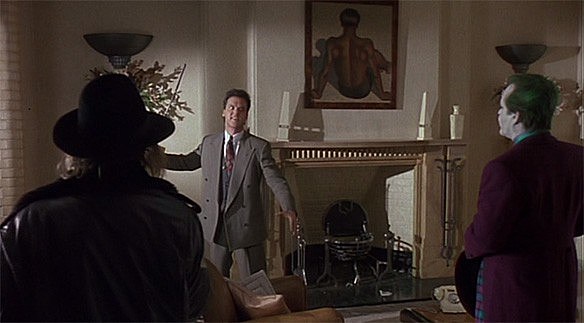
David: So Bruce provokes Joker until Joker shoots him, at which point he plays dead, but not before asking Bruce if he's ever danced with the devil in the pale moonlight, the definitive clue that lets Bruce figure out this is the dude who killed his parents. NUMBER THREE, FOR THE KIDS KEEPING TRACK AT HOME.
Chris: That line is so hack.
David: Not as bad as "never rub another man's rhubarb," which doesn't even make any sense. Also, Bruce Wayne ninja vanishes while Joker and Vicki are talking, leaving the silver plate with the bullet imprint in it for... well, no damn reason.
Chris: I think it's way worse than the rhubarb line. Hamm does that thing in the script where he admits that a line has absolutely no meaning other than sounding cool, and unlike Pulp Fiction, where Tarantino does that and actually goes back to it and makes it an underlying theme of the movie, it just lays there, having been cranked out of the Catchphrase Generating Unit they keep on the Warner backlot. Except that I guess Vicki ends up actually dancing with the Joker in the moonlight later? So he's the devil? Ugh, it's garbage. It's a major plot point that's introduced an hour and a half into a movie, and then gets immortalized in the MySpace profiles of people with truly terrible taste.
David: Vicki opens the present Joker left, and it's a porcelain hand holding wilted flowers. Adorable. She passes out, and when she wakes up, Knox has figured out what the deal with Bruce is: she finally discovers that his parents were murdered, using the amazing research power of microfiche.
Chris: I'd like to point out that at this point, Vicki's romantic choices in this movie are a) the mass murdering psychopath clown, and b) the guy who date rapes her, knocks her out and gropes her so that he can steal something from her, and shoves her down onto a couch and says "you're a real nice girl and I like you a lot but for right now, shut up." Also Knox, who is funny and charming and actually does his damn job, and even ends up saving her life. But he's not really in the running.
David: I will never understand that. He's the only person who comes out of this movie without looking like a douchebag. A bit of a lovestruck puppy, maybe, but in comparison to Napier and Wayne he's, like, Ryan Reynolds.
Chris: Compared to Keaton's Bruce Wayne, he's Danny Ocean. Who we'll be seeing in about six weeks. Where were we?
David: We were at Bruce looking at the unsolved case file for his parents' murder, which is a black binder that says "POLICE CASE - UNSOLVED" on it. It's given to him by Alfred, who gives him s*** for continuing to look into his parents' murder, a scene I don't get at all. Meanwhile, Bruce flashes back to the Batman Origin Story Shooting, which is almost a perfect metaphor for this movie, since it goes basically exactly in the Frank Miller vein, pearls and all, until Bruce drops his popcorn with the pearls. Pearls and popcorn. He also remembers a totally different, skinnier Jack Napier asking him that same dumb hacky question, thus allowing both Bruce and the viewer to figure out the Joker killed his parents. At this point, Vicki shows up, after being let in by Alfred, since the murder of his parents and ninja vanishing from her apartment had her put things together pretty quickly.
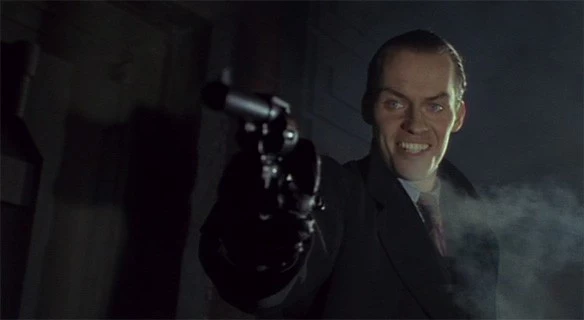
Chris: Isn't it weird how when Jack Nicholson was young, he only sort of vaguely resembled himself?
David: After a really lame relationship scene where Bruce and Vicki promise to "try to love each other," Bruce goes "but he's out there," and then... and then... Well. Now we reach the crux of things.
Chris: Yup.
David: Batman blows Axis Chemicals to Hell, with tons of people inside. But he does it with an unmanned Batmobile, so, uh, I guess that makes it ... okay?
Chris: We're talking about Batman's Batmobile that has MACHINE GUNS mounted on it and blows people up with bombs?
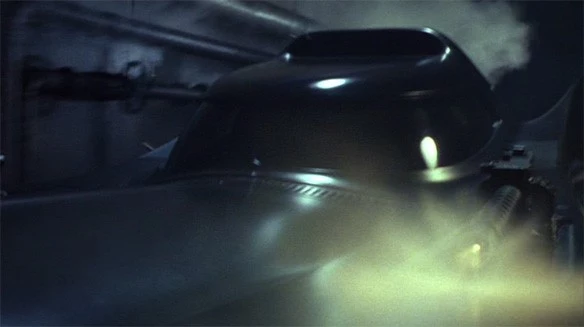
David: Yes.
Chris: Well, I'm done here. Batman kills people with bombs. I'll see myself out.
David: While researching this next scene, I discover that there was a song on Prince's Batman album called "The Arms of Orion." I'd like to think Prince was able to see the future and wrote it about Final Crisis, but I'm pretty sure that isn't the case. Because the bicentennial kicks off, and it largely consists of just the Joker and a float and throwing millions of dollars at the people of Gotham, who are apparently dumber than the citizens of the Marvel Universe, since they go "hey, yeah, let's go downtown and get free money from the guy who just poisoned every cosmetic product in Gotham." In a shocking twist, the parade balloons are filled with poison gas. Vicki is the first person to figure this out, and Knox heroically locks her in the car, grabs a gas mask and a baseball bat, and starts running in the streets trying to maintain public order.
Chris: So let me ask you a question.
David: Is Knox the real hero of this movie? Unquestionably.
Chris: I already know the answer to that one. No, my question is this: Up to this point, this entire movie has been built around the big Gotham City Bicentennial, right?
David: Yeah, that was called off by the actual city, so Joker held his own.
Chris: Yeah. So... if the Bicentennial was canceled, then why are all the people out on the street when the Joker shows up? And where did he get all the money he was throwing around? And if the Bicentennial was the one thing that was going to save Gotham from becoming a crime-ridden cesspit, and it ends up being a massive terrorist strike with nerve gas, then doesn't Gotham pretty much lose at the end of this movie, which no one acknowledges?
David: Because he announced on television earlier (I forgot to recap it) that he was going to give away millions of dollars to the public in his own Gotham Bicentennial parade float. And apparently the public in Gotham City is insanely stupid.
Chris: They did see this guy on TV talking about how he was going to kill them all like fifteen minutes ago, right?
David: And the cops and government do nothing to stop this, they basically just hope that Batman will show up in a stealth jet, cut the balloons loose with pincer razor things, fly all the way up to overlay over the moon to create a Bat-symbol to look cool to five-year-old me sitting in the student movie theatre at RPI...
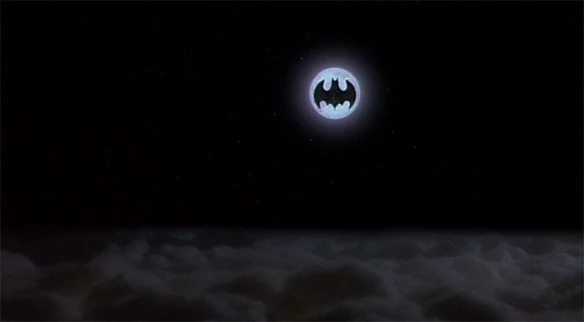
David: ...and then zoom down and start shooting at Joker, missing with every single damn shot.
Chris: One more time for those of you in the back: BATMAN SHOOTS AT A GUY WITH MACHINE GUNS.
David: I realize Batman does not regularly use guns, but I am pretty sure he also doesn't shoot like me drunk at 4:30 in the morning trying to shoot a sober guy with the lasers on a Banshee in Halo 3 on Xbox 360. So he totally sucks at shooting, and then the Joker pulls out a gun that's like the length of his leg and somehow manages to use it to shoot down an experimental stealth jet. Like, a revolver.
Chris: Because at this point, why not?
David: And he WRECKS it, I mean, it just straight-up crashes and BURNS and EXPLODES like NUTS on the front steps of Gotham Cathedral. Martians wouldn't go anywhere NEAR that thing.
Chris: I wonder if Prince felt bad about writing songs for the Joker after all this was over. The one who lives in the universe of the Batman movie, I mean. I'm sure the real Prince was just fine with it.
David: Batman is chasing Joker and Vicki Vale (who Joker's captured in the chaos) up the stairs in the cathedral when Joker shoots the cord keeping the bell up, so it falls and prevents Gordon and his men from entering, both a) reminding us that Commissioner Gordon is in this movie and b) reminding us that that Commissioner Gordon and the GCPD are hilariously inept in this movie. Batman fights some more of Joker's goons using his patented brand of "stand there and take it" martial arts while Joker dances with Vicki Vale in the pale moonlight, thus completing the movie's dumb metaphor. If the Joker is the devil, then I guess... Batman is... Jesus? Sam Hamm, you realize this isn't a Superman movie, right?
Chris: Also, in case there was any doubt about the factory, Batman straight up throws a thug to his death. Admittedly, he does it with a huracanrana, so at least we get to see some luchador action in this thing, but still. Batman killing.
David: So anyway, Vicki pretends to love Joker until Batman asks him if he's ever danced with the devil in the pale moonlight, and then beats him until he's falling off of the tower while accusing him of killing his parents. "I made you, you made me first."
Chris: Just in case anyone didn't get it before this point. Really hammer that point home, guys.
David: Batman punches him off the edge of the cathedral, but somehow he catches a ledge, and then pulls up his hands and PULLS BOTH BATMAN AND VICKI VALE OVER THE EDGE. Like, they both just flip over. That would take an INSANE amount of upper body strength.
Chris: This guy DID just bring down a fighter jet with a pistol, Uzi. He is capable of amazing things.
David: Meanwhile, the Jokercopter shows up to rescue Joker from his predicament, and while Joker's hanging onto the rope ladder, Batman, with one grapple shot, ties his leg to a gargoyle on the side of the cathedral. After Joker holds on hard enough to REMOVE THE GARGOYLE FROM THE SIDE OF THE CATHEDRAL, the strain is too much and he falls and dies.
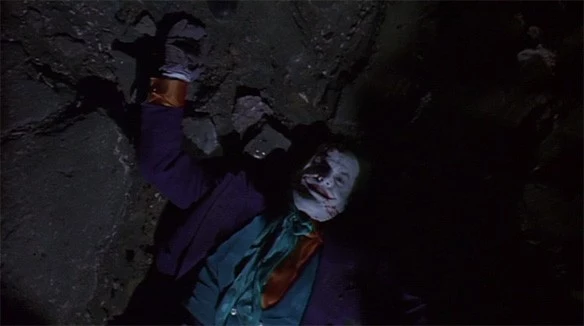
David: Batman and Vicki fall, but he saves her. Then they debut the Bat-Signal, with a letter from Batman to the people of Gotham, offering to continue fighting the "forces of evil" when necessary. Who the f--- says "forces of evil" in actual, human conversation?
Chris: I'm glad Batman has resolved to fight the forces of evil. I hope he brings down that dude who blew up the Axis Chemical factory and killed all those guys that were working there.
David: Also, Vicki completely screws over Knox and basically decides not to help him with his story after all, since she kind of likes Batman now. Adios, journalistic integrity! Vicki goes off in a limo driven by Alfred with champagne in it, both breaking open container laws and allowing her to, I guess, get smashed enough to bang Bruce Wayne again. And then, oh, thank the Lord, we are done with this movie.

David: The museum sequence.
Chris: For all our grousing, there are two really great things throughout this movie: Danny Elfman's score and Anton Furst's designs.

David: Gotham City LOOKS great - great enough that it really changed the way Gotham was portrayed in comics. It's this neo-gothic aesthetic made up half of the gothic imagery that informs Batman and half of the chemical/pipeline/thing that informs the Joker.
Chris: Quite literally: As we mentioned before, Furst's designs were used as the basis for a story where they were incorporated to make Gotham City look more... well, gothic.
David: Like, even Vicki's apartment has an exposed pipe.
Chris: Yeah! Even the fancy art museum looks like it was rivited together from scrap metal and bulkhead. I remember reading that Tim Burton's vision of Gotham was a city from Hell that brust through the crust of the Earth, and he really captures that. I just wish he'd made a movie that wasn't so dark that you can't actually see any of it. It's not just the buildings, either: I love the whole design sense of this movie, in that it's clearly set in the present -- the present of 1989, anyway -- but everyone dresses like it's the '40s. The cops all have those leather jackets, the reporters and mobsters all have three-piece suits and fedoras. It's got a definite look to it that's really appealing.
David: Honestly, technically, there's almost nothing wrong with the movie. Aside from the storytelling and script. Every shot is gorgeous, and it's tied together with an amazing score.
Chris: When you say there's nothing technically wrong with this movie, I assume that you can sense things in a way that does not require lighting.
David: Okay, touche. Granted, I saw this in a dark room on my new 40" LCD on BluRay, so the lighting problems bothered me less than they did when I was a kid watching my VHS copy on my parents' 20" CRT.
Chris: But yeah, what you can actually see of Furst's designs are really great, and do a lot to give the movie character, which is great because the script sure doesn't. Ditto for Elfman's score, which has held up as well as the John Williams's Superman theme. Maybe better, since it was also used for Batman: The Animated Series.
David: It's also worth mentioning that the neo-'40s aesthetic in this movie also really informed everything to come, ESPECIALLY The Animated Series, not to mention the look of it in the comics. I mean, what started here continued into the cartoon with the zeppelins and '40s mobster coats, and that's something that still permeates current Gotham.
Chris: Also, Bob the Goon. Especially the part where he attempted to dance.

David: The script. Oh God, the script. Also, the direction. Sam Hamm and Tim Burton are an unthinkable axis of screwing up Batman. Bruce Wayne wore glasses, for God's sake. I get that they had a conception of Batman, but it was a conception informed by a very limited cross-section of Batman stories.
Chris: It's like we said last week: Michael Keaton does not make a great Batman. Part of me wonders if he got the job just because of his eyebrows.
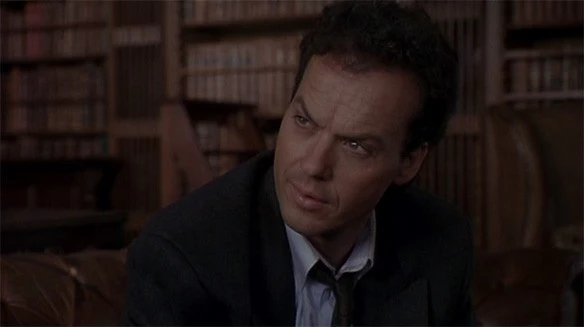
Chris: I mean, admittedly, those eyebrows are totally awesome.
David: And I do love how Chris Burnham has recently given Bruce in Incorporated those Michael Keaton eyebrows. They're just perfect arches.
Chris: No joke. But man, what ISN'T a low point of this movie? Kim Basinger is bland and boring, Jack Nicholson's not so much acting as being himself and occasionally doing a Cesar Romero impression, it's never clear what anyone in this movie wants other than Alex Knox, who wants to shtup Vicki Vale and report on the Batman and gets neither.
David: Poor Alexander Knox. Poor Robert Wuhl.
Chris: Oh, and then Batman kills a s***load of people.

David: Final thoughts? Look, we can sit here and nitpick as much as we want about how this is a crappy Batman movie and the script's dumb and you can barely make anything out, but our opinions are small drops in the bucket. Some of our commenters accuse us of overinflated selfimportance, and while I admit we kind of went out to slaughter a sacred cow here, I can't deny that this movie was a cultural monolith.
Chris: All those times I pointed out that Burton was referencing Batman '66? Those weren't complaints. I love Batman '66. But there are a ton of people, even today, who thought that this was a huge departure from that silliness, because they apparently missed the part where the Joker's poison gas parade balloons are dealt with by Batman flying a bat-shaped airplane with a giant pair of scissors that comes out from between its bat-ears. This thing's silly as all hell, and while nobody wanted to admit it back then, that's not a bad thing. The bad thing is that it's silliness that's not very good.
David: Actually, with regards to the Batman '66 comparison: you'd know more than me, but did they ever, ever address Batman's origin in it? Like, the movie or the TV show?
Chris: In the first episode, Bruce Wayne mentions that his parents were murdered and that's why he fights crime. Which, really, is all you need.
David: Yeah, I'll agree with that. This movie's really WAY campier than I remember, and let's be honest here: if you reshot this entire script with a silly cloth Batsuit, Cesar Romero and scenes that actually take place in daylight, nobody would know the difference. Like, a movie is not dark just because you have to squint to make out what's going on. A movie is dark when its subject matter is dark.
Chris: And that's something we'll be getting into again next week with the sequel, which is even more directly inspired by the Adam West show, only unwatchably terrible. Yeah, I said it.
David: Dude, what? Unwatchably terrible? I think we're really gonna be at loggerheads in seven days, dude.
Chris: Sounds like. Join us next week for our next subject, 1992's Batman Returns, in which Batman... returns.
More From ComicsAlliance









